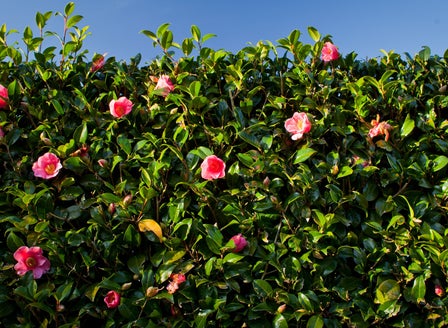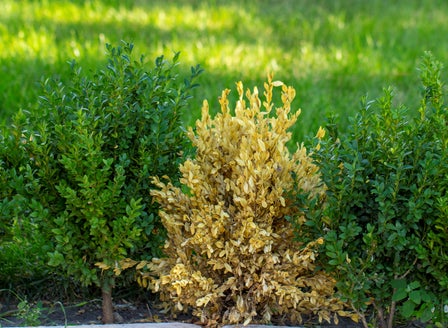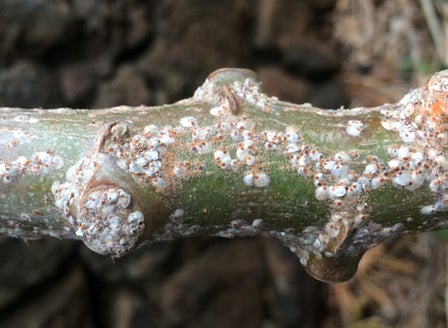Commonly referred to as English or Common Box, Buxus has been used for many years to create structure and form to gardens. With its glossy deep green small leaves and slow growth it is well suited to being clipped into shapes, hedges and low borders, suitable for containers to add drama and interest to any corner of the garden.
Planting Calendar
Buxus can be planted throughout the year.
Prepare
Position
Buxus prefers a position in full sun to partial shade. It is suited to being planted into the ground or grown in containers.
Soil
When planted into the ground hedging plants like a free draining soil that is rich in organic matter. To improve the organic content in your soil, break up the soil and add Kings Compost and Kings Sheep Pellets then mix together well. When growing in containers, plant into Kings Container mix. This mix contains added water storage crystals and Saturaid, two products that help maintain moisture in the soil
Plant
When planting into the ground, gently tap the plant out of its pot. Dig a hole twice the depth and width of the plants root ball. Mix Kings Compost into your existing soil at a 50/50 ratio, add Sheep Pellets and Kings 24 Plus Fertiliser, then mix together well. Back fill the hole with this soil, so that when planted the top of the plant’s roots sit level with the surrounding ground. Firm the soil down gently and water in well with Aquaticus Organic Garden Booster. In heavier clay soils, where drainage is likely to be an issue, plant onto a raised mound and sprinkle Gypsum Clay Breaker into the bottom of the hole, this helps slowly condition the soil and help to break down the clay. When positioning your plants, look at how the plant is already growing. Plant the bushier sides facing across from the next plant, as this will ensure your hedge fills in quicker. When planting into containers plant into Kings Containers mix, as this has water retention crystals in it, which will help in keeping the soil moist. Firm the soil down gently and water in well with Aquaticus Organic Garden Booster.
Care
Watering
Watering is essential especially in the first year of planting to allow the roots to get well established. Water slowly allowing the water to sink down into the roots, rather than allowing it to run off the top of the soil surface. Add Saturaid into the soil at planting as this will help channel the water deep down into the root zone. Consider setting up an automatic watering system – these can be simple and inexpensive.
Feeding
When planted in the ground liquid feed every month with Aquaticus Garden Booster, from Spring through to the end of Autumn, this encourages root growth and increases the microbial activity in the soil. Monthly applications of Kings Sheep Pellets will help with soil conditioning and plant health. If planted into a container feed with Kings Liquid Fast Food along with monthly applications of Aquaticus Organic Garden Booster this encourages strong roots and a healthy immune system.
Protecting
Buxus can be attacked by Buxus Blight. Regular spraying with Buxus Blight fighter and feeding with Aquaticus Garden Booster will strengthen your plants. Scale insect can also be a problem on Buxus, for treatment or better yet prevention,spray with Groventive Garden Insecticide every month or for an organic option spray with Aquaticus Bugtrol.
Mulching
Mulch around the base of the plants (making sure the Mulch does not come into direct contact with the plants stem) with Living Earth More than Mulch. Mulching helps to reduce weeds as well as aiding the soil to lock moisture into the ground.
Pruning
Regular pruning is essential if you want to create a dense, well-structured hedge. Prune after each flush of new growth. Ensure that you use sharp tools to avoid brown jagged edges on the leaves.
General Care
When using sprays, chemicals or fertilisers always read the label and follow the instructions. Apply sprays in the evening to avoid harming beneficial insects.
Beginner Tip
When growing hedges or topiaries it is important to trim back regularly. This encourages new growth, forming a thicker and more dense hedge.
Expert Tip
Buxus can be prone to attack from a naturally occurring soil borne fungus called Phytophthora. Adding Rootmate to the soil at planting and ensuring that the soil drains well, along with regular applications of Aquaticus Garden Booster will ensure a stronger more resilient plant.
Top Varieties
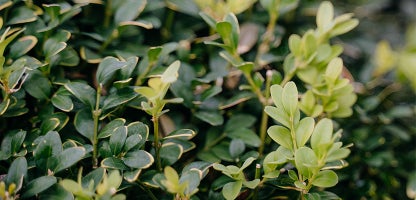
Buxus sempervirens
The original English Box, slow growing so great for topiary work and low formal hedges. Plant 20cm apart when using as a hedge.
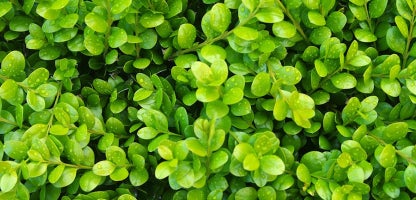
Buxus Green Gem
This varieties has a lighter bright green leaf and naturally forms a round shape. It is also more resistant to Buxus Blight. Also great for topiary work or low hedges and borders. Growing to 0.6 X 0.6.
Frequently Asked Questions
How often should I water my Buxus?
Watering is essential especially in the first year of planting to allow the roots to get well established. Water slowly allowing the water to sink down into the roots, rather than allowing it to run off the top of the soil surface. Add Saturaid into the soil at planting as this will help channel the water deep down into the root zone. Consider setting up an automatic watering system – these can be simple and inexpensive.
When and how should I prune Buxus?
Regular pruning is essential if you want to create a dense, well-structured hedge. Prune after each flush of new growth. Ensure that you use sharp tools to avoid brown jagged edges on the leaves.
What type of fertiliser is best for Buxus?
When planted in the ground liquid feed every month with Aquaticus Garden Booster, from Spring through to the end of Autumn, this encourages root growth and increases the microbial activity in the soil. Monthly applications of Kings Sheep Pellets will help with soil conditioning and plant health.
Can Buxus be grown in containers?
Yes, Buxus can be successfully grown in containers. Choose a large pot with good drainage and use a high-quality potting mix. Water regularly and fertilise every six months. Container-grown Buxus will need more frequent watering than those planted in the ground.
What is the best location to plant Buxus?
Buxus prefers a position in full sun to partial shade. It is suited to being planted into the ground or grown in containers.
